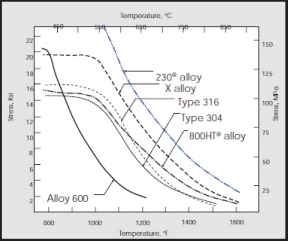Design Thinner with 230® alloy Tech Brief
“Designing Thinner” with HAYNES® Components
HAYNES® 230® alloy has many design advantages over less robust materials of construction. These include superior oxidation-resistance, metallurgical stability, fatigue strength and reparability. But the stand-out feature of 230 alloy is its excellent strength. You can design higher strength into your component by using the same thickness of construction as for other materials, or you can “design thinner” by reducing thickness, and still gain all of 230® alloy’s other advantages. The chart below shows how much gauge reduction you can achieve in comparison to various heat-resistant alloys. So when the mass of your part is important, or if heat transfer needs to be improved, “design thinner” with 230® alloy’s strength advantage. Use 2/3 to 3/4 of the thickness required for HASTELLOY® X alloy, or 1/2 to 2/3 of the thickness needed for 800H alloy. Only a third of the thickness of type 310 stainless steel is needed for the same level of strength! The same advantages exist for ASME Vessel Code construction for service up to 1650°F (900°C), although the extent of thickness reduction possible may vary somewhat. Reference to the individual code cases for comparison is recommended.
| Alloy | Service Temperature % | ||
| 1400°F (760°C) | 1600°F (870°C) | 1800°F (980°C) | |
| X | 25 | 34 | 26 |
| 800H | 47 | 51 | 39 |
| 601 | 54 | 54 | 36 |
| 253MA | 54 | 53 | 42 |
| 316L | 56 | 64 | 60 |
| RA330 | 60 | 61 | 54 |
| 304 | 63 | 68 | 63 |
| 310 | 66 | 69 | 72 |
| 600 | 71 | 63 | 45 |
| 446 | 90 | 90 | 88 |
*Based on 1000-hour rupture life strength

**Allowable design stresses
Product Description
HAYNES® 230® alloy is a top-of-the-line high-performance industrial heat-resistant alloy for applications demanding high strength, as well as resistance to environment. It is a substantial upgrade in performance capabilities from common iron-nickel-chromium and nickel-chromium alloys and displays the best combination of strength, stability, environment-resistance, and fabricablllty of any commercial nickel-base alloy.
230® alloy can be utilized at temperatures as high as 2100°F (1150°C) for continuous service. Its resistance to oxidation, combustion environments, and nitriding recommends it highly for applications such as nitric acid catalyst grids, high-temperature bellows, industrial furnace fixtures and hardware, strand annealing tubes, thermocouple protection tubes, and many more. 230® alloy is covered by ASME Section VIII, Division I and ASME Section I Code Case 2063-3, both up to 1650°F (900°C). 230® alloy is also covered by a number of ASTM and AMS specifications.
Nominal Composition
| Nickel | Balance |
| Cobalt | 5 max. |
| Chromium | 22 |
| Molybdenum | 2 |
| Tungsten | 14 |
| Iron | 3 max. |
| Silicon | 0.4 |
| Manganese | 0.5 |
| Carbon | 0.10 |
| Aluminum | 0.3 |
| Boron | 0.015 max. |
| Lanthanum | 0.02 |
Typical Tensile Properties Solution Annealed, Plate
| Test Temperature | 0.2% Offset Yield Strength | Ultimate Tensile Strength | Elongation | |||
| °F | °C | ksi | MPa | ksi | MPa | % |
| RT | RT | 57 | 395 | 125 | 860 | 50 |
| 1000 | 540 | 40 | 275 | 103 | 705 | 53 |
| 1200 | 650 | 40 | 275 | 98 | 675 | 55 |
| 1400 | 760 | 42 | 275 | 88 | 605 | 53 |
| 1600 | 870 | 37 | 255 | 63 | 435 | 65 |
| 1800 | 980 | 21 | 145 | 35 | 240 | 83 |
| 2000 | 1095 | 11 | 76 | 20 | 140 | 83 |
| 2100 | 1150 | 7 | 47 | 13 | 91 | 106 |
| 2200 | 1205 | 4 | 30 | 9 | 65 | 109 |
Typical Rupture Properties, Plate
| Temperature | Typical Rupture Properties: Stress Required to Produce Rupture | ||||||
| – | 100 h | 1,000 h | 10,000 h | ||||
| °F | °C | ksi | MPa | ksi | MPa | ksi | MPa |
| 1200 | 650 | 56.0 | 385 | 42.5 | 295 | 29.0 | 200 |
| 1400 | 760 | 27.0 | 185 | 20.0 | 140 | 14.2 | 98 |
| 1600 | 870 | 13.7 | 95 | 9.5 | 66 | 6.2 | 43 |
| 1800 | 980 | 6.0 | 41 | 3.0 | 21 | 1.6 | 11 |
| 1900 | 1040 | 3.5 | 24 | 1.8 | 12 | – | – |
| 2000 | 1095 | 2.1 | 14 | 1.0 | 7 | – | – |
| 2100 | 1150 | 1.2 | 8 | 0.6 | 4 | – | – |
Typical Room Temperature Physical Properties
| Physical Property | British Units | Metric Units |
| Density |
0.324 lb/in3 |
8.97 g/cm3 |
| Electrical Resistivity | 49.2 μohm-in | 125 μohm-cm |
| Dynamic Modulus of Elasticity (Young’s Modulus) |
30.6 x 106 psi |
211 Gpa |
| Thermal Conductivity |
62 Btu-in/ft2 -hr-°F |
8.9 W/m-°C |
| Specific Heat | 0.095 Btu/lb.-°F | 397 J/Kg-°C |
Environmental Resistance
Oxidation in Air – Excellent at 2100°F (1150°C)
Sulfidation – Equal to X alloy
Carburization – Equal to X alloy
Hydrogen Embrittlement – Excellent
Chlorination – Equal to 625 alloy
Nitriding – Best commercial alloy

 en
en